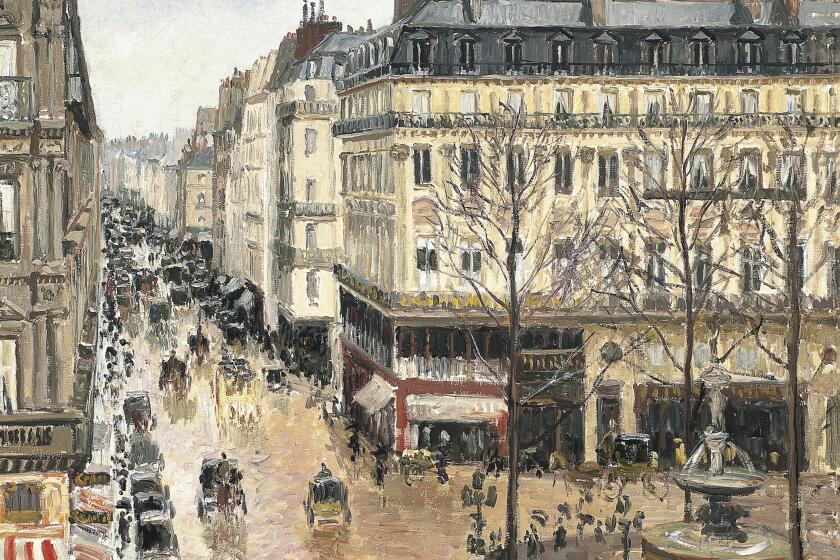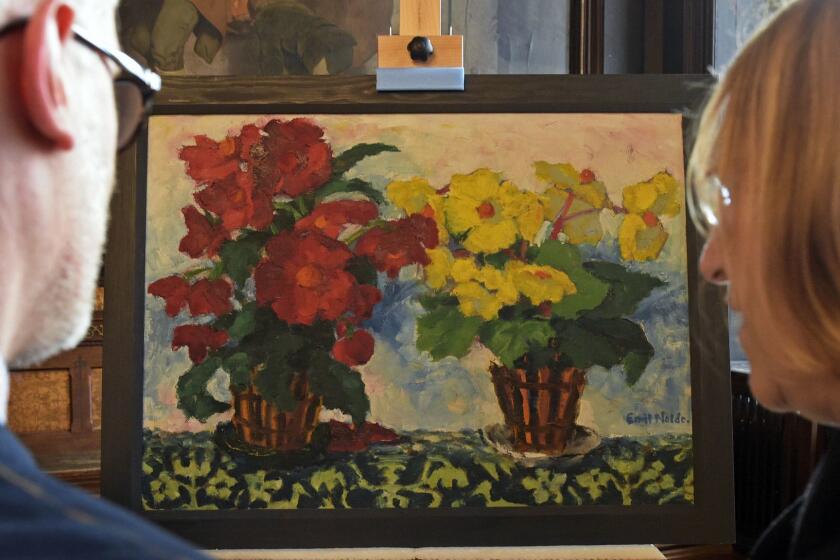Editorial: It’s outrageous that a Spanish museum refuses to return Nazi-looted art to the rightful heirs

- Share via
The family of Lilly Cassirer, a Jewish woman living in Berlin at the start of World War II, has fought for two decades in U.S. federal court to win back the Impressionist painting of a rainy Paris streetscape that was stolen from her.
Cassirer was forced by the Nazis to give up the Camille Pissarro painting, “Rue Saint-Honoré, après midi, effet de pluie,” in exchange for exit papers out of Germany in 1939.
“There is no dispute that the Nazis stole the Painting from Lilly,” declared Judge Carlos T. Bea in the opinion he wrote for a three-judge panel of the U.S. 9th Circuit Court of Appeals.
A Camille Pissarro painting looted by Nazis from a Jewish woman in Berlin rightfully belongs to the Spanish museum that ultimately acquired it, or so a U.S.
And yet the panel ruled that a Spanish museum, which has displayed the painting since 1992, should be allowed to keep it.
The legal issue here may be complicated, but the moral issue is clear and simple. The painting belongs to the Cassirer heirs. It’s outrageous that it still hangs on the wall of the Museo Nacional Thyssen-Bornemisza, a museum in Madrid. The museum knows it was looted by the Nazis. The whole world knows. And yet there it hangs for all the world to see — a stolen masterpiece.
Of course, the museum should have simply returned the painting long ago to the Cassirer family. The Spanish government, which owns the museum, and nearly four dozen other countries signed the nonbinding international agreement, the Washington Principles, to seek fair solutions in cases of looted art when owners or heirs can be identified. Museum officials have long contended that they didn’t know the painting’s dark history when they bought it in 1993 from Baron Hans Heinrich Thyssen-Bornemisza, who has since died. The baron, a sophisticated art collector, should have known that the painting had been looted. And the museum should have done a better job of researching the painting’s provenance — its journey through various hands.
The Supreme Court ruled for the Jewish family seeking to recover a Pissarro painting that was looted by a Nazi official in 1939.
But the museum has fought to keep the painting. Even one of the judges on the 9th Circuit panel, Consuelo M. Callahan, wrote in her concurrence that the decision was “at odds with our moral compass” and that Spain “should have voluntarily relinquished the Painting.”
So how did we end up with the 9th Circuit ruling on whether a museum with a stolen piece of art can continue to hold and display it?
Lilly Cassirer’s grandson and sole heir, Claude, moved to California in 1980, and first filed a lawsuit in 2005 under the Foreign Sovereign Immunities Act. The case has gone from federal district court to appellate court several times to the U.S. Supreme Court and now back to the 9th Circuit.
The looting of art by the Nazis during World War II was, arguably, the greatest cultural theft of all time.
The issue before the court this time was whether to apply the law of California or the law of Spain regarding stolen property. In an amicus brief, California Atty. Gen. Rob Bonta argued that the court should apply California law since the state “has long and vigorously enforced the ability of its residents to recover stolen art.”
The three-judge panel decided that Spanish law trumped California law, because Spain’s governmental interests would be more impaired by applying California law than California would be hurt if they applied Spanish law. In California, once something is proclaimed stolen, the thief never has a right to it and cannot pass on title to it. In Spain, when something is stolen, the latest holder has a right to it after a certain amount of time passes and no one has come forward to claim it as theirs.
Judge Bea noted that even under California law, there is a statute of limitations on how long a victim has to file a lawsuit — six years from the time the victim discovers the whereabouts of the stolen property. However, in this case, the Cassirer descendants filed only five years after they discovered the painting was in the museum. The family’s lawyers will ask the court for a rehearing.
This fight should have been resolved years ago. It is shameful that the museum and the Spanish government refuse to do what is just and moral, which is to return the painting that Lilly Cassirer hung on the wall of her apartment in Berlin.
More to Read
A cure for the common opinion
Get thought-provoking perspectives with our weekly newsletter.
You may occasionally receive promotional content from the Los Angeles Times.











